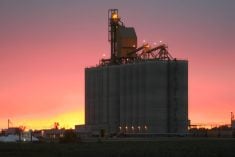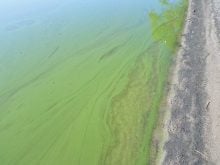Sometimes a failed cropping experiment isn’t failure at all. When Bob Blackshaw set out to evaluate growing a cover crop without sacrificing cash flow, he certainly didn’t expect to happen upon an effective new way to establish alfalfa or to pinpoint a new silage mix. But that’s exactly what happened.
“If you look back at the actual study’s objectives, it was largely a failure,” Blackshaw says. The weed scientist with Agriculture and Agri- Food Canada in Lethbridge, Alta., set out to follow three legumes for three years seeded with winter wheat in the fall or frost-seeded in the spring. The aim was to judge winter survival of the under-seeded red clover, alfalfa or Austrian winter pea, and to measure each crop’s contribution of nitrogen to the following canola crop, as well as provide weed suppression and erosion protection. The goal was to add a crop without reducing the winter wheat yield.
Read Also

Cancer agency reclassifies another herbicide ‘probably carcinogenic’
The WHO’s cancer research agency has now put atrazine, a herbicide well known to corn growers, in the same potential-hazard category where the agency put glyphosate.
Two of three under-seeded crops had undesirable outcomes, based on the set objectives, and the frost-seeding trial failed every year. The trial established that the red clover wasn’t winter hardy enough for fall seeding, that the winter pea competed too effectively with the winter wheat and reduced its yield and that all three crop types seeded into the existing spring crop never got big enough to contribute much nitrogen, Blackshaw says.
FALL-ESTABLISHED ALFALFA CAN WORK
But for all those hard lessons, some very promising, though unexpected, findings did come out of the research. First, fall-seeded alfalfa did very well in the trial and survived all three years. Second, the Austrian winter pea not only survived winter, but it also grew a little too well the next year.
Alfalfa proved to be the real winner in this trial. It was set up like this: Once the winter wheat crop was harvested in late summer, the legume (red clover, alfalfa or winter pea) was allowed to grow, providing ground cover to guard against weeds and erosion while fixing nitrogen. The alfalfa was sprayed out with a heavy dose (1.5 litres per acre) of glyphosate in the fall with good kill each year. “We sprayed when the alfalfa was still actively growing with good results,” Blackshaw says.
Blackshaw and his team measured the extra available nitrogen added by the alfalfa intercrop the next spring. The alfalfa consistently left 15 to 17 pounds per acre for the next crop that was available at seeding time. Over the course of the summer, approximately another 15 pounds per acre was made available through natural soil processes. “This is continually released nitrogen, so it’s available at the critical grain filling period,” unlike conventional, spring-applied nitrogen products. he says.
The alfalfa did not reduce the winter wheat crop yield in each of the three years, meaning that the added nitrogen and weed and erosion control came at no cost to yield whatsoever.
OTHER CONSIDERATIONS
Blackshaw notes there were few drawbacks to seeding a legume with the winter wheat crop, but there are some key points to consider. Seed cost of the alfalfa is one, of course. Seeding two very different-sized seeds at the same time can be tricky, too. If you’re not set up with a unit that can do it (the research team used a drill with two boxes), it could mean two field passes to get both in the ground, adding significant costs and time. Alternatively, if you’ve got a double shoot opener or if you could seed in alternating rows, you can make it work, Blackshaw says.
If water is scarce, it should be noted that while the alfalfa/winter wheat intercrop didn’t use significantly more water from the shallower rooting zones, it did deplete deeper water reserves somewhat. “We’re talking two percentage points difference,” Blackshaw says, meaning that in most years the difference won’t be significant.
There’s also the cost of terminating the alfalfa crop in the fall. For those who typically do a burnoff in the fall anyway, the added cost might only be a bit higher due to the higher rate of glyphosate, however Blackshaw notes this is where another positive possibility came out of the study.
“We had several farmers come through who said the crop looked so good, they’d just leave it for hay for the next four or five years,” Blackshaw says. While under-seeding alfalfa for establishment is not a new practice, it’s typically done in the spring, not the fall. Fall seeding does seem to work, Blackshaw says, providing farmers one more option for establishing alfalfa.
WINTER PEA AS SILAGE ADDITION
And what of the Austrian winter pea trial? Blackshaw says that the study confirms Austrian winter pea is a viable option — in the Lethbridge area, at least. “It not only survived all three winters, but it also grew so well the following spring, it negatively impacted winter wheat yields,” Blackshaw says.
Because a focus of this trial was to maintain winter wheat yields, the winter pea treatment was deemed a failure. In practice, however, Blackshaw has had more than a few farmers from the area light up at the results. “They’re looking at it as a silage option,” he says, noting that the winter pea will boost protein content of the silage. That certainly wasn’t a goal of this study, he says, but it’s a very positive outcome.
“Cover crops have largely been the domain of organic producers,” Blackshaw concludes, “but this work suggests that conventional farmers can include a legume in their cropping system without negatively impacting the main crop.” The added plant-available, slow-release nitrogen is only one spin-off benefit: improved weed control, erosion control and long-term improved soil structure follows as well.
LyndseySmithistheeditorofGrainews.
Contactherat [email protected].














